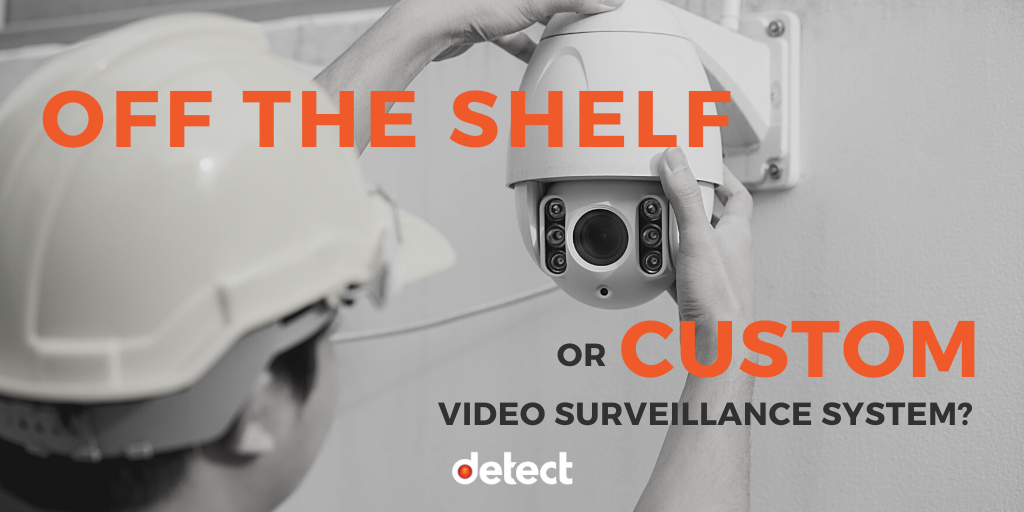So, you’re ready to invest in a surveillance system. The all-in-one systems offered at the big box stores seem like they would work, but are they really good enough to provide all of your security needs, or do you need to invest in a professional video management system (VMS)?

What are the options?
There are a number of solutions available for camera systems. You can break them down into three levels, each increasing in sophistication and options for customization.
Big Box Solution
These are generally low-end cameras connected to a Digital Video Recorder (DVR) loaded with proprietary software. The cameras connect by coax or via Wi-Fi interface and support a maximum of eight cameras. They have some features that allow remote access through the web or via a smart phone app, tend to be limited in camera quality and recording resolution. The biggest selling point is their affordability, and can be readily replaced when they fail.
NVR Hybrid Solution
This solution offers a higher level of functionality, centered around a Network Video Recorder (NVR) that forms the core of the system. The more affordable models are still running an embedded operating system, but the more robust systems are based on a complete Windows Server platform, and cameras are connected and powered by Ethernet cables. Some of the more affordable NVR’s support hybrid connectivity—that is, they will support both analog and IP cameras. These solutions support more cameras and have a richer feature set than the big box solution, and they generally have a longer service life.
Custom VMS Solution
This is the highest level of surveillance, where the Video Management System (VMS) is the focal point, or brains, of the operation. The VMS unifies, controls, and communicates with the various components, and has a layer of intelligence capable of responding to conditions and events occurring within the cameras field of view. This makes the system proactive, instead of simply reactive to recorded events. A good VMS can and should be modified to meet a specific customer’s needs. This solution is the most expensive, but it provides the highest level of service and functionality. All components are fine tuned for ultimate efficiency for smooth operation within your environment, and the system should come with some level of support.
There are a pros and cons for each level, so let’s take a look at five common decision points: ease of installation, cost, usability, scalability, and support.
Ease of Installation
The most obvious benefit of a DVR or NVR appliance compared to a VMS system is ease of installation and configuration. Generally, NVR video is viewed via web browser or smart phone app, so there is no software to install. For smaller installations with just a handful of cameras, this reason alone is often why customers choose NVRs over VMS software. The tradeoff for this fast and easy deployment is that you have to buy a complete solution. You will be locked into whatever camera hardware comes in the bundle and the capacity of the NVR, both of which put a technological expiration date on the usability of the product.
On the flip side, VMS software solutions are able to leverage existing hardware, or include relatively cheaper hardware. And the larger your system installation, the more important this becomes. This is especially true as system sizes scale, so even if your company is starting with a small set of cameras, try to anticipate future needs as well. Of course, installation and setup are more complex, although with industry trends such as wi-fi-enabled cameras and phone clients, it may not be as much of a complication as you might think.
Cost
Off-the-shelf solutions are readily available for a few hundred dollars. They come with typically four or eight cameras and a recorder to store video. Sometimes the cameras need to be hardwired, but some may be battery or solar powered. Most use a wi-fi connection to send video to the storage device. A somewhat technical person can generally install the package without professional support. This solution may work well, particularly for a small indoor installation, but typically these packages are fairly low end and have short life spans, which ends up costing money in the long run. In a nutshell, you get moderate DIY functionality for a low cost.
It’s harder to estimate the cost of a VMS, because installations are customized to meet the requirements of the customer and environment. The hardware is selected based on what will perform best, and budgets are variable. Installation is going to be more complicated, and completed by a technical professional, but will also be guaranteed and warrantied in case anything goes wrong. Storage requirements are designed to comply with any regulations or rules, and footage can be securely watermarked and shared. If you need professional quality and reliability, a VMS is probably the better choice.
Usability
The concept of usability covers a lot—intuitiveness, reliability, scalability, and more—but the general thing about usability as it relates to NVR vs. VMS is that the usability of boxed solutions is designed for smaller deployments and more casual use, whereas the usability of a VMS is most often designed for larger systems, with multiple users, and a higher system load.
VMS systems tend to have a sharper learning curve than off-the-shelf systems, but they also offer compatibility with third-party hardware and plugins that the closed systems don’t. If need to control access to your system, a VMS will handle that better. If you need to use more than one or two monitors at the same time, that’s another place that a VMS outperforms an NVR system. That said, usability boils down to whether the surveillance system you selected is appropriate for the environment it has been tasked with.
Scalability
Scalability is not the strong point of a box system. If your initial system comes with 8 cameras, and you decide you need 10, you need to purchase an entire additional unit. Of course, you can expand up to 16 someday, but what if you don’t need to for another 3 years? Or what if you need additional storage, but no more cameras—you still need to buy a new package. It’s a big investment for very little return. And as you add more and more, it becomes apparent that the usability factor just isn’t designed to accommodate large systems.
On the other hand, flexibility and scalability are where a VMS really shines. You can add additional cameras as you need them, and adjust storage requirements accordingly. Maybe you need a specialized infrared camera, or a super high-resolution camera, or a motion-detecting camera—no problem. With a VMS you aren’t locked into a particular manufacturer, you can just use what works. And as technology improves, cameras and DVRs can be upgraded piecemeal as needs and budgets allow.
Support
When a customer buys an off-the-shelf box, everything comes from one manufacturer, with hardware that was designed for that specific use. Theoretically, these solutions should be easier to support, because everything from installation to troubleshooting to warranty issues can be handled by one company. That said, you’re relying on that company to be able to handle your problems, and if the manufacturer cannot or will not respond appropriately, you may find yourself watching YouTube videos to learn to fix your own system. There’s also a risk that if something goes terribly wrong, you’ll have to disassemble and return the entire kit.
With a VMS installation, you’ve got human support: design professionals and installation experts, as well as someone to call if you need help. A good shop will take the time to build a relationship with you and your business, understand your needs, preferences, and constraints, and stand beside you for the lifespan of your surveillance system.
Making Your Decision
The choice is rarely black and white. The decision really depends on the size of the system you want to deploy, the potential future requirements, and ultimately, how the system will be used. Leverage DETECT designs complete VMS systems, but we also recognize that heavy coverage isn’t for everyone. Maybe you need just the video viewing software to work with your existing cameras, or an upgrade to what you already have. Why not give us a call? We are happy to discuss your needs and find a solution that fits your budget.

